Saturday, October 28, 2006
Going to Glacier
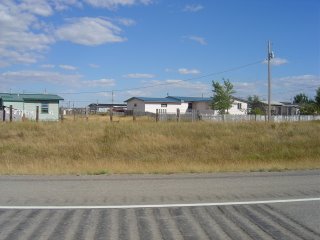 It takes me a while to find Rosalyn again, since while I was at the museum she moved from the Cuts Wood School to what she refers to as the "World Headquarters" of the Piegan Institute. There's no particular reason it takes me a while to find her; the directions she gave me turn out to be flawless and the place is only about six blocks away. But I manage to get lost amid one street of crackerbox houses after another and have to ask for directions again, in a place that's almost directly across the street from my destination.
It takes me a while to find Rosalyn again, since while I was at the museum she moved from the Cuts Wood School to what she refers to as the "World Headquarters" of the Piegan Institute. There's no particular reason it takes me a while to find her; the directions she gave me turn out to be flawless and the place is only about six blocks away. But I manage to get lost amid one street of crackerbox houses after another and have to ask for directions again, in a place that's almost directly across the street from my destination.Rosalyn is sitting with Shirlee, whom I met at the school, and with the executive director of the Piegan Institute, Darrell Kipp. Darrell is a big man with graying hair pulled back in a ponytail, and he's sitting and talking while Shirlee does something that looks like actual work and Rosalyn listens. He asks about my trip across the High Line, what I've seen and done. I get into it a ways and soon we're swapping stories of the emptiness of the eastern Montana.
Darrell tells about a girl he once dated who was from Scobey, Montana. I passed a large billboard advertising Scobey on my way through, and although there were some plausibly interesting things mentioned on it I looked at the map and decided it was too far off the beaten track for even me on even this adventure, as if there's some other adventure I might take where Scobey would be a justifiable part of the itinerary. Darrell talks about driving out there and seeing a house out by itself, miles from anything else, and wondering what the man who lives in that house does with his day - does he get up, and go out and sit on his porch, and look at nothing until it's time for lunch?
It's more or less a thought that's occurred to me over and over again in the last week or so. If you're wondering how vast and empty that part of the world is, it's the part of the world that people in Browning, Montana, think is vast and empty.
Darrell is a raconteur with the best of them, and we pass a couple hours talking. Or "visiting," as Darrell likes to say - he tells of meeting someone: "so we visited for a while." It does occur to me that the others in the room, who may have heard some of these stories before, maybe more than once, might just as soon visit a little less this afternoon. But I'm pretty entranced.
Eventually we depart and I follow Rosalyn through town to her mom's house, which is in a newer subdivision at the north end of town. To the west are mountains and fire. It's been a heavy fire season this summer, and Rosalyn points to a new one with huge billows of smoke in the mountains of Glacier Park to the west.
Rosalyn and Angie and I visit for a while - local news that I know nothing about, the fires, family history. Angie shows me a picture of her grandparents in the living room, in full Indian costume - and costume is the right word. The picture is from a postcard printed by the Great Northern Railroad to drum up passenger business. One of the featured attractions was the opportunity to see real, live Indians at Glacier Park. So Angie's grandparents earned money by standing at the entrance to Glacier, dressed the part.
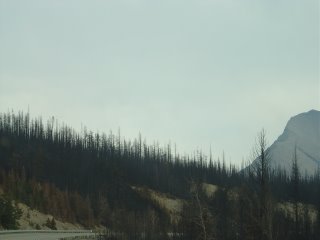 Then, in the late afternoon, we get back into our cars and drive over the ridge to Glacier National Park, where I'm going to camp for the night. Near the top of the ridge the aftermath of the fires is on display. Whole hillsides are covered with charred spikes; in places the road itself is burnt black.
Then, in the late afternoon, we get back into our cars and drive over the ridge to Glacier National Park, where I'm going to camp for the night. Near the top of the ridge the aftermath of the fires is on display. Whole hillsides are covered with charred spikes; in places the road itself is burnt black. We head down the mountain to some property belonging to Rosalyn's uncle, on the shore of Lower St. Mary Lake, or possibly St. Mary's Lake, or if you prefer the Walled-In Lakes, or the Old Woman Lakes. It's beautiful and cold, which is partly due to latitude and partly due to its surprising depth. On its banks grow sarvis berries, which we've come to pick. In the driveway there's some evidence that bears have come to pick them recently, too. (Sarvis berries are like a less-sweet blueberry; Rosalyn tells me that Dave, who spent even more of his youth in the blueberry growing regions of Michigan than I did, isn't too fond of them. Good blueberries are, I must admit, superior, but I wouldn't dismiss sarvis berries out of hand. And today, they win by forfeit. The Canadians, incidentally, call them Saskatoons.)
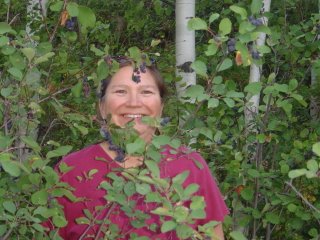 Here's a picture of Rosalyn picking berries. There would be a superior picture of Rosalyn and Angie together here, but your correspondent rushed the shot, and then didn't bother to look at it right away, and that's the way that goes.
Here's a picture of Rosalyn picking berries. There would be a superior picture of Rosalyn and Angie together here, but your correspondent rushed the shot, and then didn't bother to look at it right away, and that's the way that goes.It's starting to get dark - I'm suddenly in the mountains, and the dark comes on quickly - so we head back down the road to the campground at Glacier National Park. There are signs warning of bears in the area. I'm made to promnise to do a long list of things to keep bears away, like lock all my food in the car or a bear locker, and not have any perfumes and cosmetics in the car with me. They haven't been bothering campers, the friendly park ranger assures, me, adding, "and we want to keep it that way."
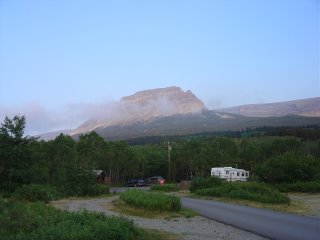 I pick a site, frankly without working too hard, and it's not perfect, but it does provide a substantially different view than what I've been looking at in recent weeks. Angie and Rosalyn help me put up my tent. Angie doesn't seem too impressed by it; "That would never make it during Indian Days," she tells me. They give me a big bag of sarvis berries and leave me to face the grizzlies alone.
I pick a site, frankly without working too hard, and it's not perfect, but it does provide a substantially different view than what I've been looking at in recent weeks. Angie and Rosalyn help me put up my tent. Angie doesn't seem too impressed by it; "That would never make it during Indian Days," she tells me. They give me a big bag of sarvis berries and leave me to face the grizzlies alone.Thursday, October 05, 2006
Browning
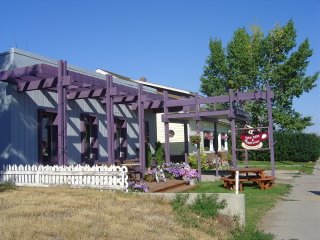 West of the Sweet Grass Hills, I pass through Shelby, which 100 years ago was bisected by a railroad called the "Turkey Track." Today it's bisected by I-15. There are two coffee joints, both of them so cute it makes my teeth hurt. I choose the one with internet access. It's called "Cowboy Coffee," and it's painted purple and filled with shelves of potpourri, and no self-respecting cowboy would be caught dead in it.
West of the Sweet Grass Hills, I pass through Shelby, which 100 years ago was bisected by a railroad called the "Turkey Track." Today it's bisected by I-15. There are two coffee joints, both of them so cute it makes my teeth hurt. I choose the one with internet access. It's called "Cowboy Coffee," and it's painted purple and filled with shelves of potpourri, and no self-respecting cowboy would be caught dead in it.On west through Cut Bank, where I find another payphone and call Reggie first and then Rosalyn's mom, to tell her I'm getting close. I'd like to romanticize this part of the trip, but I can find nothing appealing about the towns I'm rolling through today. So it's a relief to come over the rise and see the town of Browning laid out before me.

Browning is the biggest town on the Blackfeet Reservation. Or possibly the Blackfoot Reservation. I've heard both, and the historical interest sign is no help. It's titled "The Blackfeet Nation," and it begins, "The Blackfoot Nation consist of three tribes ...."
 I'd like to romanticize Browning, too, particularly because I have relatives who spend a lot of time here, but it looks as dismal as anything I've heard about Indian reservations. Devoid of shade and water, wind-blown, full of houses that testify to the government's tendency to do things on the cheap whenever they involve actual people (leaving open, for now, the question of whether the government regarded Indians as actual people when it built this place).
I'd like to romanticize Browning, too, particularly because I have relatives who spend a lot of time here, but it looks as dismal as anything I've heard about Indian reservations. Devoid of shade and water, wind-blown, full of houses that testify to the government's tendency to do things on the cheap whenever they involve actual people (leaving open, for now, the question of whether the government regarded Indians as actual people when it built this place).Dogs range up and down the streets. There's a main drag that has a few gas stations, an IGA, a big A-frame building with "Trading Post" painted on the roof in 20-foot high letters, and a few unappealing restaurants. Oh, and an enormous concrete teepee that houses an espresso bar.
I pull in at a diner housed in a log cabin. It's full of friendly, helpful people who let me use their phone when I explain I'm trying to call my cousin's mom in town. The waitress assures me the cowboy soup, which is made not from cowboys but from hamburger and macaroni, is good, and it is, in a salty, beefy, homey kind of way. There are three firemen on their lunch break proving that firemen are hotties regardless of the location or culture, and an extremely overweight family, and a table of tourists who look even more curious about these Indians than I am, and more intimidated than I've become after spending two or three weeks learning to assume that everyone I encounter is going to be friendly and helpful.
 Angie, Rosalyn's mom, gives me directions to the Cuts Wood School, which is where she says I can find Rosalyn. I walk in and find Rosalyn right there, without warning, and we each give the other a startled hello, as if it's passing strange to see this familiar person here in this place that's on the other side of the middle of nowhere.
Angie, Rosalyn's mom, gives me directions to the Cuts Wood School, which is where she says I can find Rosalyn. I walk in and find Rosalyn right there, without warning, and we each give the other a startled hello, as if it's passing strange to see this familiar person here in this place that's on the other side of the middle of nowhere.Cuts Wood School is a tiny little place, the next thing to a one-room school, where elementary and middle-school children learn in the Blackfoot language. It's bright and cheerful inside, a school that kids might feel good about walking into, and the walls are covered with pictures of everyday things labeled with their Blackfoot names. Everyone half-apologizes and half-complains about the pile of packs and bedrolls left by a group of do-gooder college students from somewhere who have come to Browning to paint houses or some such thing.
We sit and talk for a few minutes, Rosalyn and her colleague Shirlee and I and a one or two other folks who are around here during the summer. I want to ask about something, so I ask about the "Blackfoot/-feet" thing, and based on Shirlee's reaction I can see I've asked an exasperating question, possibly because it's a stupid little thing that nobody can resolve, or possibly because it's the stupid sort of thing that white people ask about when they come to Browning. But even stupid questions can lead to interesting answers, and I find out about the three tribes that make up the Blackfoot Nation and some of their history. (The three tribes are the Siksika, or "Blackfoot," the Kainai, or "Bloods," and the Piegans. It's mostly Piegans who live in Browning and on the Blackfeet reservation in the US; the Cuts Wood School is run by an organization called the Piegan Institute. The Piegans aren't known by the English translation of their name, which seems to have something to do with being poorly clothed.)(As long as we're into this: they mostly say Blackfoot in Canada and Blackfeet in the US. "Blackfeet" seems to have resulted from some bureaucrat's conclusion that if there's more than one member of the nation, the name had to be plural. And now we can let this topic go for a while.)
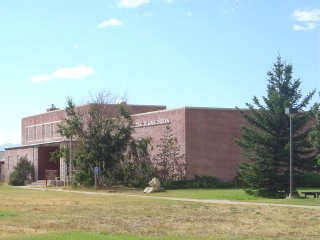 Rosalyn has some things to do, so I head off to the Museum of the Plains Indian, which is over at the edge of town near the construction site for the new casino. Rosalyn looks a little sideways at this idea, and I ask her about it, and she explains that it's probably worth doing, it just hasn't changed since she first went there many years ago. She tells me not to miss the movie narrated by Vincent Price.
Rosalyn has some things to do, so I head off to the Museum of the Plains Indian, which is over at the edge of town near the construction site for the new casino. Rosalyn looks a little sideways at this idea, and I ask her about it, and she explains that it's probably worth doing, it just hasn't changed since she first went there many years ago. She tells me not to miss the movie narrated by Vincent Price.It's not a bad museum, but it's pretty stale compared to the whiz-bang stuff you get today. Vincent Price movie, there is none; the woman at the front desk tells me it broke several years ago. She doesn't seem disappointed that it broke. She offers to recreate it for me word-for-word, but I pass.
The displays have a lot of clothing in them, and other crafts, and I realize that just about every Hollywood stereotype of an Indian that you've ever seen comes from Plains Indians - teepees, feather headdresses, buckskin pants (which aren't pants but actually just pant legs, assembled with a loin cloth). Some toys and games are displayed as well - one of them is a hoop that the young men would try to throw a spear through, and based on the size of the hoop, it was either an endlessly frustrating game or they were pretty good with spears.